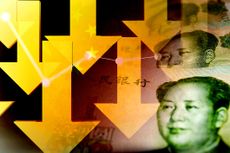Nervous investors miss out on Japan's biggest stockmarket rise in 26 years
British investors pulled £145m from Japanese funds in September. But they are missing out – Japan’s Nikkei 225 index gained 15% in November, its best monthly showing since 1994.

Japanese prime minister Yoshihide Suga has announced a new ¥73.6trn (£532bn) stimulus package, the country’s third so far this year. About ¥40trn (£289bn) will go towards furlough programmes, hospitals and incentives for green investment. The stimulus takes the total spent on the country’s virus to 14% of GDP.
Japan has so far dodged the worst of the pandemic, but the latest wave is its most serious, says William Pesek for the Asia Times. Japan has a serious “pre-existing condition” – about 30% of the population are aged over 65 and that proportion is rising. The debt-to-GDP ratio is more than 230% and is climbing towards 250%. “Massive national debt, a plunging population, and now, a resurgent pandemic… talk about a grim convergence.”
Upside in view
The “outlook for Japan is actually not looking too bad”, writes Robert Carnell for ING Think. More women participating in the workforce and longer careers have mitigated the “worst fears” about an ageing population. The government has been forced to step in with extra fiscal support because the Bank of Japan has run out of firepower; the central bank now owns “more than 50%” of all government debt. Its $433bn share portfolio also makes it the country’s biggest stockmarket investor. ING expects GDP to contract 5.4% for 2020 as a whole and for the economy to regain its pre-crisis level in late 2022.
Subscribe to MoneyWeek
Subscribe to MoneyWeek today and get your first six magazine issues absolutely FREE

Sign up to Money Morning
Don't miss the latest investment and personal finances news, market analysis, plus money-saving tips with our free twice-daily newsletter
Don't miss the latest investment and personal finances news, market analysis, plus money-saving tips with our free twice-daily newsletter
Japan’s Nikkei 225 index gained 15% in November, its best monthly showing since 1994. But it remains about one-third short of its 1989 all-time peak. The Topix, which is a more accurate (if less famous) gauge of the stockmarket, is up by 3.5% so far this year.
British investors pulled £145m from Japanese funds in September, according to Investment Association data, says Jayna Rana for the Daily Mail. The wobble may have been induced by Shinzo Abe’s resignation as prime minister. They are missing out. A pro-shareholder culture is slowly taking hold thanks to Abe’s reforms, while Suga is now pushing digitalisation in a country still attached to fax machines.
The Nikkei 225 index has outperformed the US market in dollar terms this year, but few international investors have noticed, writes Mike Bird in The Wall Street Journal. Overseas buyers cooled on Abe in mid-2015 and have withdrawn funds again this year. Yet 2021 is expected to be a good year for cyclical stocks, such as industrials and consumer discretionary, which comprise “almost 40% of the MSCI Japan” index. Japanese firms also have less leverage than their overseas counterparts, which gives them a strong cash buffer for dividends – Japan yields 2.3%. When global investors cotton on, the market could soar.
-
 Rightmove: Asking prices edge closer to record peak
Rightmove: Asking prices edge closer to record peakAsking prices have been driven up by the top-end of the market, Rightmove has found. But how does the situation look in your area?
By Vaishali Varu Published
-
 Coventry Building Society bids £780m for Co-operative Bank - what could it mean for customers?
Coventry Building Society bids £780m for Co-operative Bank - what could it mean for customers?Coventry Building Society has put in an offer of £780 million to buy Co-operative Bank. When will the potential deal happen and what could it mean for customers?
By Vaishali Varu Published
-
 The industry at the heart of global technology
The industry at the heart of global technologyThe semiconductor industry powers key trends such as artificial intelligence, says Rupert Hargreaves
By Rupert Hargreaves Published
-
 Three emerging Asian markets to invest in
Three emerging Asian markets to invest inProfessional investor Chetan Sehgal of Templeton Emerging Markets Investment Trust tells us where he’d put his money
By Chetan Sehgal Published
-
 What to consider before investing in small-cap indexes
What to consider before investing in small-cap indexesSmall-cap index trackers show why your choice of benchmark can make a large difference to long-term returns
By Cris Sholto Heaton Published
-
 Why space investments are the way to go for investors
Why space investments are the way to go for investorsSpace investments will change our world beyond recognition, UK investors should take note
By Merryn Somerset Webb Published
-
 Time to tap into Africa’s mobile money boom
Time to tap into Africa’s mobile money boomFavourable demographics have put Africa on the path to growth when it comes to mobile money and digital banking
By Rupert Hargreaves Published
-
 M&S is back in fashion: but how long can this success last?
M&S is back in fashion: but how long can this success last?M&S has exceeded expectations in the past few years, but can it keep up the momentum?
By Rupert Hargreaves Published
-
 The end of China’s boom
The end of China’s boomLike the US, China too got fat on fake money. Now, China's doom is not far away.
By Bill Bonner Published
-
 Magic mushrooms — an investment boom or doom?
Magic mushrooms — an investment boom or doom?Investing in these promising medical developments might see you embark on the trip of a lifetime.
By Bruce Packard Published